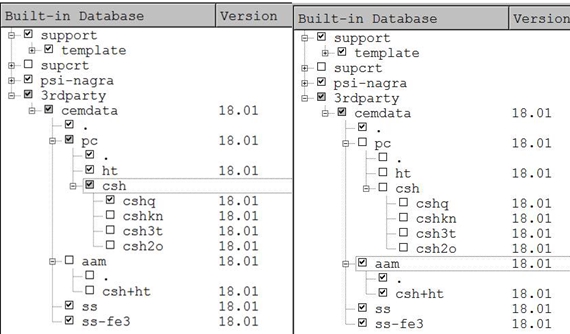Thermodynamic data
Cemdata
|
Thermodynamic data for hydrated solids in Portland cement system (CaO-Al2O3-SiO2-CaSO4-CaCO3-Fe2O3-MgO-H2O) - New version CEMDATA 18.1 available - |
||
|
The first version of the cement specific cement database Cemdata was published in 2007-2009. Since then it was updated several times; the last update has been published in 2019 (Lothenbach et al. 2019) Cemdata18 database in GEM-Selektor v.3 format is compatible with the GEMS version of the PSI/Nagra 12/07 TDB (http://gems.web.psi.ch). As several alternative C-S-H models, as well as two models for hydroxide-hydrotalcite are available (see Lothenbach et al., 2018) the user needs to select the appropriate models during the generation of new projects, as illustrated in Figure 1. The CSHQ and the OH-hydrotalcite with Mg/Al = 2 are well adapted for Portland cement systems (select cemdata, pc, ht and cshq as indicated at the left hand side of Figure 1). For alkali activated binders, the CNASH model has been developed for C-S-H type calcium (alkali) aluminosilicate hydrate gels with lower calcium but higher aluminium and alkali content. An Mg-Al layered double hydroxide model with variable Mg/Al ratio is also available for use in alkali activated cement systems. For alkali activated binders, the selection of cemdata, aam and deselection of pc including ht and csh is recommended as illustrated at the right hand side of Figure 1. |

CEMDATA at 25 °C
At 25 °C the solubility products (KS0) of the CEMDATA data set is fully consistent with the thermodynamic data for aqueous species, gases, and common minerals such as portlandite or gypsum, provided in the PSI/Nagra-Thermodynamic Data Base 12/07 and 01/01 (Thoenen et al. 2014; Hummel et al., 2002) and can be used together with the Nagra/PSI TDB in any thermodynamic modelling software.
CEMDATA at 0-100 °C
The CEMDATA data base covers hydrates commonly encountered in Portland cement systems in the temperature range 0-100 °C. In the temperature range 0-100 °C the CEMDATA data base is compatible with the GEMS default kernel database (GEMS version of PSI/Nagra data base). Hence, the CEMDATA files comprise a specific extension to the GEMS kernel data base.
Further information on the CEMDATA data base see:
- Lothenbach, B., Kulik, D., Matschei, T., Balonis, M., Baquerizo, L., Dilnesa, B.Z., Miron, D.G., Myers, R. (2019) Cemdata18: A chemical thermodynamic database for hydrated Portland cements and alkali-activated materials Cement and Concrete Research, 115,472-506 https://doi.org/10.1016/j.cemconres.2018.04.018
Further information on GEMS see:
- Wagner T., Kulik D.A., Hingerl F.F., Dmytrieva S.V.: GEM-Selektor geochemical modeling package: TSolMod library and data interface for multicomponent phase models, Canadian Mineralogist 50 (2012), 1173-1195.
- Kulik, D.A., Wagner, T., Dmytrieva, S.V., Kosakowski, G., Hingerl, F.F., Chudnenko, K.V., Berner, U.: GEM-Selektor geochemical modeling package: revised algorithm and GEMS3K numerical kernel for coupled simulation codes, Computational Geosciences 17 (2013), 1-24.
To use the CEMDATA18 data base in GEMS-PSI package, please download it to your hard disk and perform the following steps:
- Unzip the downloaded zip file (contains a directory named "DB.default") into a temporary directory, e.g. as /Tempfiles/DB.default
- Find where you have GEMS installed (on Windows, usually under C:\Users\"your name"\GEMS39\Gems3-app\Resources\DB.default). Under Linux, this may need a root password.
-
Copy all files from /Tempfiles/DB.default into the DB.default directory.
-
Start GEMS and create a new project. In the "Selection of Independent Components..." dialog, turn on "Kernel(Nagra-PSI)" and "cemdata". This will link the CEMDATA database files as a specific extension to the kernel Nagra-PSI database. "Solutions" will cause GEMS to take Phase records for cement solid solutions, such as C-S-H or ettringite.
- Select Independent Components to form the system and click "Ok" to proceed as usual.
Download of the PHREEQC version of CEMDATA
CEMDATA data base developed together with the auxiliary information from the Nagra/PSI-Thermodynamic Data Base was converted to PHREEQC-format for temperatures 0-100 °C. The PHREEQC version of CEMDATA18 including the general data from the Nagra/PSI-Thermodynamic Data Base is available here.
Download of the Geochemist's Workbench version of CEMDATA
The Cemdata18 thermodynamic database is also available for use with The Geochemist's Workbench software (formatted by Brian Farrell). The database is compatible with current releases of the free GWB Community Edition, as well as paid versions of the package. You may download the database directly from their website or from here.
Further information on the CEMDATA data base see:
- Lothenbach, B., Kulik, D., Matschei, T., Balonis, M., Baquerizo, L., Dilnesa, B.Z., Miron, D.G., Myers, R. (2019) Cemdata18: A chemical thermodynamic database for hydrated Portland cements and alkali-activated materials Cement and Concrete Research, 115, 472-506 https://doi.org/10.1016/j.cemconres.2018.04.018
Updates:
Cemdata 18.1 (released 8-1-2019): definition and data for INFCNA corrected to (CaO)1(SiO2)1.1875(Al2O3)0.15625(Na2O)0.34375(H2O)1.3125 as given in Table 4
Addition of zeolite and MSH to PHREEQC version
Cemdata 18.11: Addition of C4FeCl2H10 (Fe Friedel's salt ideal composition) and reactions for Fe(OH)3(am) and Fe(OH)3(mic) to the PHREEQC and Geochemist's Workbench version

Prof. PD. Dr. Barbara Lothenbach
Senior Researcher / Projektleiterin / Adjunct Prof. NTNU
-
Share
